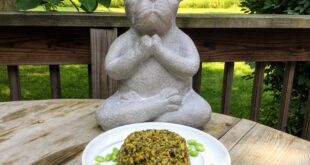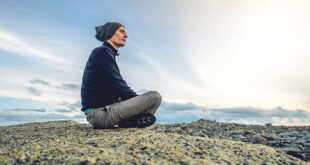By Bharat Kalra –
When I talk about “my body,” I am declaring that I am separate from my body. When I say “my mind,” I am declaring that I am not my mind. But, if I am not my mind or body, then what am I? Long ago, human life revolved around three basic needs, food, clothing, and shelter. All activity focused on making sure these three needs were met. As societies evolved and advanced, two more basic values emerged, values of vital importance still to this day, health and happiness.
What makes us healthy? What makes us happy? These two questions were seen as different matters. “Health” referred to bodily functions and was a matter for science. “Happiness” was seen as a state of mind and a matter for philosophy.
The great thinkers in science and philosophy always saw the link between health and happiness. Remember Benjamin Franklin’s famous aphorism “Early to bed, early to rise…”? As our understanding of how the mind works advanced scientifically, the importance of mental health to physical health (and vice versa) became clearer.
We found that worry and stress tended to make people more vulnerable to illness. Happy people were more resistant to disease. Studies in longevity revealed the importance of a positive attitude. The whole concept of the placebo is based on the platform that having positive thoughts can ultimately affect physical conditions. Thus, we know our thoughts influence our health. Meditation—a method for focusing and “training” our thought—can have a tremendous impact on our physical wellbeing.
What is Stress?
If asked to describe good health, I might say it is the absence of disease. I would say happiness is the absence of grief and sadness. Similarly, meditation can be understood only when we can define stress, which can be a positive force. In human history, finding food, clothing and shelter was prompted by the stress of not having these things. So, stress that prompts us to act is positive stress. Positive stress helps us carry on with our day-to-day life. When the body needs water, the brain tells us to pick up the glass and pour some water. When the bladder is under stress, we know what we need to do.
While reading this article, close your eyes and observe what is going on in your mind. Do this for ten minutes without interruption. You will realize just how crazy our inner world can be with multiple thoughts crossing the mind every minute, most of them totally irrelevant. When you analyze these thoughts, you observe that most are either connected to the past or to the future. The past is gone and can’t be changed, while the future remains out of reach. Both are effectively out of our control.
Stress is the by-product of fear—the anxiety of feeling that the past and the future are out of our control. The body is prompted to take action, but this action never takes place. Negative thoughts take shape and grow in the mind. This creates negative stress.
Meditation
The present is the link between the past and future. This link carries the secret key to the happiness we have been discussing. That key is meditation. Meditation is nothing but the art of disconnecting from the past and anxiety about the future and learning to live in the present moment.
Sometimes meditation is described as concentration; this is true to a very limited extent. With the mind so full of thoughts, concentration on any one subject is a tool to minimize and focus mental activity. Then when the mind starts fully concentrating on that one object, even that object is removed. What is left for which the mind to hang? Nothing! That is when real meditation starts. We learn the art of not doing anything and become observers, rather than doers.
Therapeutic Value of Meditation
Meditation enhances positivity and decreases stress and negative thinking. Research also shows it increases the ability to concentrate, mental focus and memory. Meditation has proven physical benefits as well. When we change our mind, we change our body; recent neurological studies show this is literally true. Researchers are demonstrating that meditation can be a powerful, even essential ally in healing, recovering and correcting a great variety of physical conditions. Through a determined practice of meditation, one can learn to redirect and refocus neurological activity. Studies actually show increases in brain signaling connections and protective tissue. In other words, with meditation, we are not feeling better just because we spent some time relaxing; we are physically healing our bodies.
Recently, I was treating a patient with cold lasers for swelling caused by a dental abscess. I took her into a meditative state and asked her to observe the inflamed part. This process was repeated two or three times. After the session was over, she said she was healed, with a mild memory of the wound still present. Her dentist the next day observed it was remarkable how quickly she had healed. I mention this patient because she is a practicing doctor herself.
Spirituality
One of the great things about meditation is it doesn’t conflict with your particular type of spiritual practice; in fact, one can approach meditation as an empiricist—a scientific observer. With an open, attentive mind, meditation can deepen and enhance your existing spiritual practice, whatever form that may be.
“If I am neither mind nor body, then what am I?” Once you ask this question, the world within comes upon the threshold of upheaval, and nothing remains the same. The answer to this question lies in meditation.
A recent Indian master puts it this way: “One cannot ‘do’ meditation. Meditation just happens. Meditation means just ‘to be.’ Meditation happens only when all activities cease on a physical and mental level and what remains is just ‘the being’… No activity, no thought, no emotion. This ‘to be’ is just bliss. Where is the source of this bliss? How can you be blissful when you are not doing anything? This is possible because this is happening without any reason. Existence itself is bliss.”
Guided Meditation
Talking about meditation, even if it is an experienced teacher explaining, is no substitute for the experience. When starting your journey, a guide is crucial to getting the most out of the experience. Simply sitting quietly is only a start, and it is far more difficult than people realize. A teacher can instruct in techniques, help you focus and let go, show you what to look for and where and act as a conduit to the meditative state.
Guided meditation is like a show window; it gives a glimpse of what is in store for you. When you experience deep relaxation, you think “Wow! That was great. I never thought relaxation could be so profound and blissful.” Guided meditation is a preparatory step on the journey to silent meditation. People sometimes ask me to describe the feeling after a session. I have to pause. Can it be adequately described? Can you describe the taste of chocolate? You might say it is sweet. You might say it is rich. But the only way to truly know is to taste it. Come experience the taste of chocolate for yourself!
Bharat Kalra, LMT conducts Guided Meditation sessions at various locations in NW Chicago. His goal is to help people learn to relax and allow the body to heal itself. He is also a practicing massage therapist. His massage sessions include hands-on work, Reiki, Craniosacral Therapy, breathing and guided meditation.
 Conscious Community Magazine Dedicated to Elevating Consciousness
Conscious Community Magazine Dedicated to Elevating Consciousness





